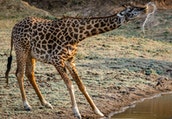- 1. Africa Buffalo Physical Description African buffaloes are large and robust animals, with males being larger than females. They can reach shoulder heights of up to 1.7 meters (5.6 feet) and weigh between 500 and 900 kilograms (1100 to 2000 pounds). They have a stocky build, a broad chest, and a thick, curved set of horns that form a characteristic "boss" on their forehead.
- 2. Africa Buffalo Distribution and Habitat: African buffaloes inhabit a wide range of habitats across sub-Saharan Africa, including grasslands, savannas, woodlands, and swampy areas. They are found in countries such as South Africa, Kenya, Tanzania, Botswana, Zimbabwe, and others. They have adapted to various ecological conditions and can tolerate both open areas and dense vegetation.
- 3. Africa Buffalo Behavior: African buffaloes are highly social animals and live in herds that can consist of a few individuals to several hundred members. The herds are typically led by a dominant female, and males often form bachelor groups. Buffaloes communicate using various vocalizations, body postures, and scent marking. They are known for their strong sense of hearing and smell.
- 4. Africa Buffalo Diet: African buffaloes are herbivores and primarily graze on grasses. They are bulk grazers, meaning they consume large quantities of grass to meet their nutritional needs. During the dry season when grass is scarce, they may also browse on leaves, shrubs, and herbs. Their grazing behavior contributes to the shaping of grassland ecosystems.
- 5. Africa Buffalo Threats and Predation: African buffaloes face several threats in the wild. They are susceptible to habitat loss, fragmentation, and hunting for their meat, hides, and horns. Predators such as lions, crocodiles, and hyenas pose a threat to buffaloes, particularly to young or weakened individuals. Buffaloes display a strong defense mechanism and are known to fiercely defend themselves when threatened.
- 6. Africa Buffalo Conservation Status: The African buffalo is classified as a species of "Least Concern" by the International Union for Conservation of Nature (IUCN) due to its large population size and widespread distribution. However, regional populations may face local declines and conservation challenges in certain areas.
- 7. Africa Buffalo Ecological Role: African buffaloes play an important ecological role as grazers and ecosystem engineers. Their feeding behavior influences vegetation structure and dynamics, which, in turn, affects other herbivores, birds, and insects. They are considered a keystone species in many African ecosystems.
- 8. African Hornbill: Africa is home to several species of hornbills, known for their large bills and often colorful casques. The Southern Ground Hornbill (Bucorvus leadbeateri) and the African Grey Hornbill (Tockus nasutus) are examples of species found in Africa.
Africa Buffalo:
The African buffalo, also known as the Cape buffalo (Syncerus caffer), is a large and formidable bovine species native to sub-Saharan Africa. Here are some key facts about African buffaloes:








 |
|  |
|  |
|  |
| 